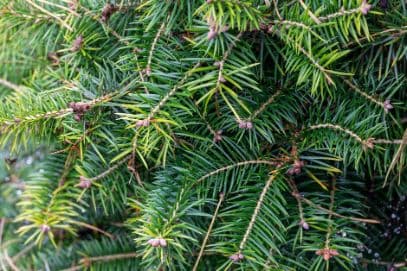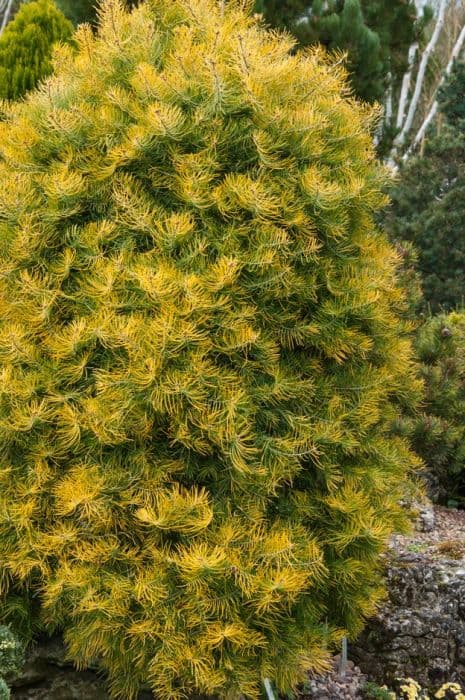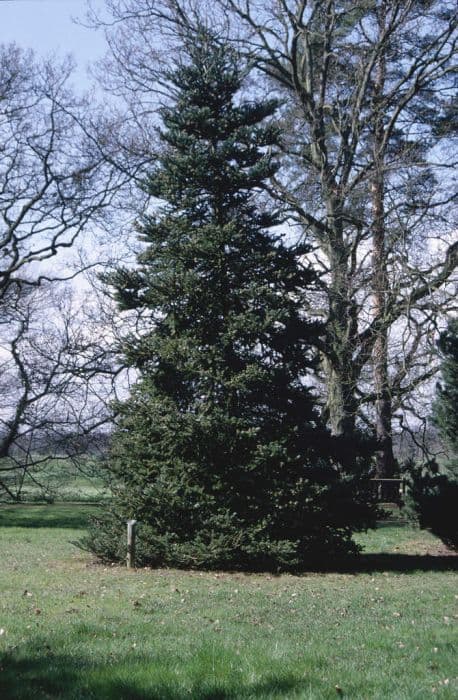Bosnian Pine Pinus heldreichii 'Compact Gem'

ABOUT
The Pinus heldreichii 'Compact Gem', also known as Bosnian Pine 'Compact Gem', is a miniature version of its larger relatives, boasting a distinctive dense, slow-growing habit. Its needles are arrayed in pairs, presenting a luscious dark green color that endures throughout the year, contributing to its evergreen status. The needles themselves are stiff and stout, with a slightly curved form, radiating around the branches to create a full, rich appearance. This particular variety, being a compact gem, is characterized by a particularly neat, rounded to broadly conical shape, giving it an orderly, well-groomed look which is particularly appealing in formal garden settings or as a specimen plant. The branches are also compact, closely spaced together, enhancing the dense look of the tree. Oftentimes, the branching pattern and the tight, uniform foliage provide an appealing texture that stands out in landscapes. The tree's bark is rugged and scaly, with a grey-brown color that forms an attractive contrast with the vibrant green of the needles. Cones may develop as the plant matures; these start out small and green, gradually turning to brown as they age and dry. They are often held upright on the branches, adding an additional ornamental feature to the plant. Overall, its appearance exudes robustness and resilience, while maintaining a refined and ornamental character.
About this plant
 Names
NamesFamily
Pinaceae
Synonyms
Bosnian Pine, Heldreich's Pine, Compact Gem Pine
Common names
Pinus heldreichii 'Compact Gem'.
 Toxicity
ToxicityTo humans
The Bosnian pine is generally not considered toxic to humans. Most species in the genus Pinus are not poisonous, and there is no widely known toxicity associated with the Bosnian pine. Ingesting parts of the plant typically does not result in symptoms of poisoning.
To pets
The Bosnian pine is also not considered toxic to pets. It is not known to contain any compounds that are harmful to animals if ingested. Therefore, ingestion of parts of the Bosnian pine generally should not cause any major symptoms of poisoning or serious consequences for pets. However, it's always possible for individual animals to have a unique reaction or for non-toxic plants to cause mechanical issues like obstruction if ingested in large quantities.
 Characteristics
CharacteristicsLife cycle
Perennials
Foliage type
Evergreen
Color of leaves
Green
Height
2-3 feet [60-90 cm]
Spread
2-3 feet [60-90 cm]
Plant type
Tree
Hardiness zones
4-8
Native area
Balkans
Benefits
 General Benefits
General Benefits- Low maintenance: Compact Gem pine requires minimal care once established, making it suitable for gardeners of all skill levels.
- Drought resistance: Once established, this variety can tolerate periods of dry conditions without the need for frequent watering.
- Cold hardy: It is capable of withstanding cold temperatures, making it suitable for many climates.
- Compact size: The 'Compact Gem' remains small and manageable, ideal for smaller gardens or spaces.
- Evergreen foliage: Providing year-round color and structure to the landscape.
- Architectural interest: Its distinct shape and dense growth habit can serve as a focal point in garden design.
- Wildlife habitat: Offers shelter and potential nesting sites for birds and other wildlife.
- Low risk of pests and diseases: Generally resistant to many common pests and diseases, reducing the need for chemical treatments.
- Soil adaptability: This pine can adapt to a variety of soil types, although it prefers well-drained conditions.
- Ornamental cones: Produces attractive cones that add to the visual interest of the plant.
 Medical Properties
Medical PropertiesThis plant is not used for medical purposes.
 Air-purifying Qualities
Air-purifying QualitiesThis plant is not specifically known for air purifying qualities.
 Other Uses
Other Uses- The dense growth habit of Bosnian Pine can make it a suitable plant for bonsai cultivation, where enthusiasts can prune and shape the plant over the years to create a miniature landscape feature.
- Wood from mature Bosnian Pine trees may be used in the construction of musical instruments, particularly for crafting the soundboards of string instruments where resonant wood is desirable.
- The tree's resin can be collected and used in the production of certain varnishes and adhesives, exploiting its natural sticky properties.
- Bosnian Pine's sturdy wood can be fashioned into rustic furniture pieces such as benches and tables for outdoor use, adding a natural aesthetic to garden settings.
- Fallen pine needles from the tree can be gathered and used as a natural mulch in gardens, helping to retain soil moisture and suppress weeds.
- The tree can serve as a living Christmas tree for those who prefer to use a potted tree during the holidays that can be planted afterward.
- The slow growth and compact size of Bosnian Pine make it an ideal species for use in model railway landscapes and other dioramas, providing a realistic miniature tree appearance.
- Bosnian Pine cones can be collected and used for crafting projects, such as making wreaths or as natural decorations during the fall and winter seasons.
- When strategically planted, the Bosnian Pine can act as a windbreak or a natural snow fence, helping to reduce wind speed and snow drifts in colder climates.
- The distinctive shape and texture of the Bosnian Pine make it a unique subject for photography enthusiasts and painters who are inspired by natural forms and landscapes.
Interesting Facts
 Feng Shui
Feng ShuiThe Bosnian Pine is not used in Feng Shui practice.
 Zodiac Sign Compitability
Zodiac Sign CompitabilityThe Bosnian Pine is not used in astrology practice.
 Plant Symbolism
Plant Symbolism- Resilience: The Pinus heldreichii 'Compact Gem', commonly known as the Bosnian pine, can thrive in harsh conditions, symbolizing the ability to persist and remain steadfast in the face of adversity.
- Longevity: As a species that can live for hundreds of years, the Bosnian pine represents long life and timeless endurance.
- Peace: Pines are often associated with serenity and tranquility, embodying a sense of calm and peace.
- Wisdom: With their ancient lineage and growth over centuries, Bosnian pines are seen as symbols of wisdom and knowledge accumulated over time.
- Steadfastness: The sturdy nature of the Bosnian pine, with its strong roots and imposing presence, represents reliability and a grounded character.
 Water
WaterThe Bosnian Pine 'Compact Gem' prefers consistent moisture but is quite drought tolerant once established. It's important to water this conifer deeply and infrequently to encourage a strong root system. A young 'Compact Gem' should be watered about once a week with about 1-2 gallons of water, depending on the weather conditions. As the tree matures, natural precipitation will often be sufficient, but during extended periods of drought, you should provide supplemental water. In hot, dry climates, water the tree every 2-3 weeks with 3-4 gallons of water, while in cooler climates, once a month may be adequate.
 Light
LightThe Bosnian Pine 'Compact Gem' thrives in full sunlight. It performs best when it receives at least six hours of direct, unfiltered sunlight each day. This conifer should be placed in a location where it is exposed to bright, direct light for the majority of the day to maintain its health and compact growth habit.
 Temperature
TemperatureThe Bosnian Pine 'Compact Gem' is hardy and can tolerate a wide range of temperatures, from cold winters to hot summers. It can withstand temperatures down to about -20°F and is comfortable in summer temperatures that climb well above 80°F. The ideal temperature range for robust growth is between 60°F and 75°F. This conifer is well-suited for growing in zones with these temperature ranges and can endure occasional temperature extremes outside of them.
 Pruning
PruningThe Bosnian Pine 'Compact Gem' typically requires little pruning. Pruning may be done to shape the tree or remove damaged or diseased branches. The best time to prune is in late winter or early spring before new growth starts. It's rarely necessary to prune annually; instead, prune as needed to maintain the desired shape and health of the pine.
 Cleaning
CleaningAs needed
 Soil
SoilBosnian Pine 'Compact Gem' thrives best in well-draining, slightly acidic to neutral soil with a pH range of 6.0 to 7.5. An ideal soil mix can be created using one part peat, one part pine bark, and one part coarse sand or perlite. This mix ensures proper drainage and aeration, which is critical for the health of the pine's roots.
 Repotting
RepottingThe Bosnian Pine 'Compact Gem' does not need frequent repotting and can be done every 3 to 5 years. It's important to repot only when the plant has outgrown its current container, as pines generally prefer to be left undisturbed and have a sensitive root system.
 Humidity & Misting
Humidity & MistingBosnian Pine 'Compact Gem' prefers dry to moderate humidity levels as it is adapted to the drier conditions typical of high-altitude or Mediterranean climates.
 Suitable locations
Suitable locationsIndoor
Ensure bright light, cool temp, regular watering.
Outdoor
Full sun, well-draining soil, protect from harsh winds.
Hardiness zone
4-7 USDA
 Life cycle
Life cycleThe Bosnian Pine 'Compact Gem' begins its life cycle as a seed, often requiring a period of stratification to break dormancy before germination occurs. Upon germination, the seedling grows through a juvenile phase characterized by rapid height growth and the development of its root system. As the tree matures into the sapling stage, it starts to develop a more defined shape with a compact growth habit. Over many years, the 'Compact Gem' reaches maturity, featuring a dense, symmetrical form with evergreen needles and developing cones. The mature tree then enters a reproductive phase, during which it produces both male pollen cones and female seed cones, relying predominantly on wind for pollination. Eventually, as part of its life cycle, the 'Compact Gem' will decline in vigor, leading to its eventual death, at which point it releases its seeds to continue the cycle.
 Propogation
PropogationPropogation time
Spring-Early Summer
Propogation: For the Bosnian Pine, scientifically known as Pinus heldreichii 'Compact Gem', the most popular method of propagation is by seed. The optimal time for sowing seeds is generally in the fall, allowing them to stratify naturally during the cold winter months. However, for controlled propagation, stratification can be done artificially by keeping the seeds in a refrigerator at 34-41 degrees Fahrenheit (1-5 degrees Celsius) for about 90 to 120 days to break dormancy. Once stratified, seeds should be sown in a well-draining soil mix, a quarter-inch deep, and kept moist until germination, which can take several weeks. Due to the slow growth habit and the specific varietal characteristics of 'Compact Gem', this method, while effective for species propagation, may not produce offspring with the exact same characteristics as the parent plant.









